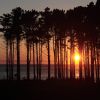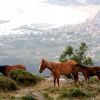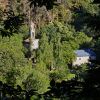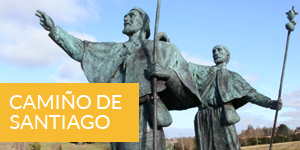- Accede I
- Regístrate I
- carrito
Rías Baixas - Barbanza: Paisajes Míticos
Duración: 1 día completo
Itinerario: Noia - Castro de Baroña - Furnas - Dunas Corrubedo - Dolmen Axeitos - Curota - Pobra do Caramiñal - Padrón
Descripción: Paisajes de la película ganadora del Oscar® “Mar Adentro”. Con pasado celta, es una tierra rotunda, de fuertes contrastes, señoreada por la sierra del Barbanza, un enorme bloque de granito que se mete en el mar separando dos de las Rías Baixas: la de Muros e Noia y la de Arousa. Esta zona concentra importantísimas áreas de interés paisajístico –Mirador de A Curota, donde caballos y vacas viven en libertad-, natural –Dunas de Corrubedo- y arqueológico -como el espectacular Castro de Baroña o el solitario Dolmen de Axeitos-, además de villas marineras con pasado medieval, como Noia y A Pobra do Caramiñal.
Paradas recomendadas
Noia-Castro Baroña-Dunas Corrubedo-Curota-Pobra do Caramiñal-Padrón
La comarca del Barbanza es una tierra de fuertes contrastes dividida por la sierra de O Barbanza, un enorme bloque de granito que se mete en el mar separando las Rías Baixas de Muros-Noia de la de Arousa. En un espacio relativamente pequeño, esta zona concentra importantísimas zonas de interés paisajístico, ecológico y arqueológico.
El paisaje, de formas rotundas y salvajes en sus montes, que son balcones privilegiados sobre las Rías Baixas, da paso a extensos arenales blancos y lagunas en su costa, destacando por su importancia natural el complejo dunar de Corrubedo, que incluye las lagunas de Carregal y Vixán. Está además jalonado por monumentos megalíticos y prehistóricos (celtas), como el espectacular castro de Baroña, y por villas marineras con pasado medieval. En la sierra de O Barbanza, miles de caballos y vacas viven en total libertad, en contacto con la naturaleza y el viento del mar.
Son los mismos paisajes que recorre la película 'Mar adentro' ganadora del Oscar a Mejor Película de Habla No Inglesa 2005, del director Alejandro Amenábar y basada en la historia real de Ramón Sampedro, tetrapléjico durante 28 años a causa de un accidente en el extraordinario conjunto de cavidades rocosas de la playa de As Furnas.
Ría de Muros y Noia
Las rocas graníticas condicionan la mayor parte de los paisajes naturales de esta ría, como queda patente en la península acantilada del castro de Baroña, en el margen meridional, y en el monte Louro, en el septentrional, que es uno de los montes más bonitos de Galicia, y protege, cual bastión defensivo, las transparentes aguas y los arenales de esta ría.
Ría de Arousa
La más extensa de las Rías Baixas remata por el norte con la brusca sierra de O Barbanza, mientras que por el sur la bordean las tierras de perfiles suaves de la península del Salnés. La salpican numerosas islas e islotes como Sálvora en su entrada, Arousa, en su sector central, y Cortegada en su fondo, casi en contacto con la desembocadura del río Ulla.
La ría tiene un perfil sinuoso, con numerosas ensenadas, calas y pequeñas penínsulas que favorecieron el asentamiento de un rosario de villas marineras. La amplitud de la ría propició que desde antiguo fuera una vía abierta al comercio, pero también a las invasiones medievales de normandos y árabes, de cuya presencia son testigo las defensivas Torres de Oeste, en Catoira. Según la leyenda, por esta ría llegó hasta Padrón, población situada en el vértice de la ría, la barca que transportaba las reliquias del Apóstol Santiago.
Noia
Situada en el fondo de la ría de Muros y Noia, esta población fue importante en la historia de Galicia, y conserva todavía un interesante casco antiguo de origen medieval. En la villa hay dos templos que figuran entre los más importantes de la arquitectura gallega: Santa María A Nova (s. XIV), que contiene interesantes lápidas gremiales, y San Martiño (s.XV). Destaca también el de San Francisco y, en cuanto a espacios urbanos, la rúa de O Curro, con la Casa de la Escuela de Gramática.
Castro de Baroña
'Castro' es el nombre que recibe un tipo de poblamiento característico, defendido por parapetos y fosos, que existió en el noroeste de la Península Ibérica y particularmente en Galicia, desde la Edad del Hierro hasta muy avanzada la romanización. Las viviendas que más comúnmente se relacionan con los castros son de una típica forma circular, similares a las famosas 'pallozas'.
El castro de Baroña es espectacular porque se encaja de proa en el mar. Situado sobre una península que sólo se une a tierra por un pequeño istmo de arena, esta ubicación y su buen estado de conservación, lo convierten en uno de los más hermosos e impactantes escenarios de la cultura 'castrexa' y 'celta'. El castro está declarado Patrimonio Artístico Nacional.
Dolmen de Axeitos
El dolmen de Axeitos, llamado popularmente Pedra do Mouro lleva con nosotros 4.000 años. Tuvo, como todos los monumentos megalíticos de este tipo, uso funerario. El dolmen estaba oculto bajo un túmulo de tierra y tenía un pasillo de entrada, hoy desaparecido, orientado hacia el sol naciente.
Dunas de Corrubedo
La gigante duna móvil de la playa de Corrubedo, formada por un conjunto de dunas continuamente remodeladas por el viento, es única en el litoral de España por su tamaño - alcanza 2,5 km de largo y puede llegar a los 15 m de alto-, y porque la acompañan dos lagunas: una de agua dulce (Vixán) y otra de agua salada (Carregal), que componen una zona de marismas de alto interés natural. En la cercana playa de O Vilar hay un Centro de Interpretación del Ecosistema Litoral Gallego con interesante información de este entorno natural protegido.
Ribeira
Santa Uxía de Ribeira es un pueblo económicamente pujante por la importancia de su puerto pesquero, que conserva todavía algunos restos de la antigua villa marinera.
A Curotiña
A 368 m sobre el nivel del mar, la cumbre Curotiña es el mejor lugar para tener una perspectiva casi aérea de las Rías Baixas y, en días claros, incluso hasta Portugal. Desde allí se comprueba la serenidad característica de las rías mientras, a nuestros pies, barcos, bateas y pueblos marineros parecen figuras de una enorme maqueta. Y pastando aquí y allá, los caballos salvajes de O Barbanza, los verdaderos señores del paisaje.
A Pobra do Caramiñal
Villa señorial resultado de la unión de dos poblaciones anteriores, que al hermanarse compusieron el topónimo de esta población. Tiene casas blasonadas y castillos como las Torres de A Xunqueira. Flota sobre la villa la sombra de Ramón María del Valle-Inclán (1866-1936), uno de los principales literatos de Galicia -autor de obras como Tirano Banderas, Sonatas, Luces de Bohemia o Divinas Palabras-, que tiene aquí su museo . A Pobra es muy coqueta, sobre todo su alameda, orgullo de sus habitantes.
Padrón
Padrón es el primer topónimo que aparece en la leyenda más importante de Galicia, la leyenda jacobea, porque allí fue donde arribó la barca que trasladaba los restos del Apóstol Santiago. En el casco histórico de Padrón merecen ser visitados, además de las rúas, el 'Pedrón' del que habla la leyenda, el convento del Carmen, con mirador sobre la villa, y la casa de la poetisa romántica Rosalía de Castro. La ruta está marcada por dos ríos, el Sar y el Ulla, y por sus amables y productivas vegas, en las que nacen los archiconocidos pimientos de Padrón.

























